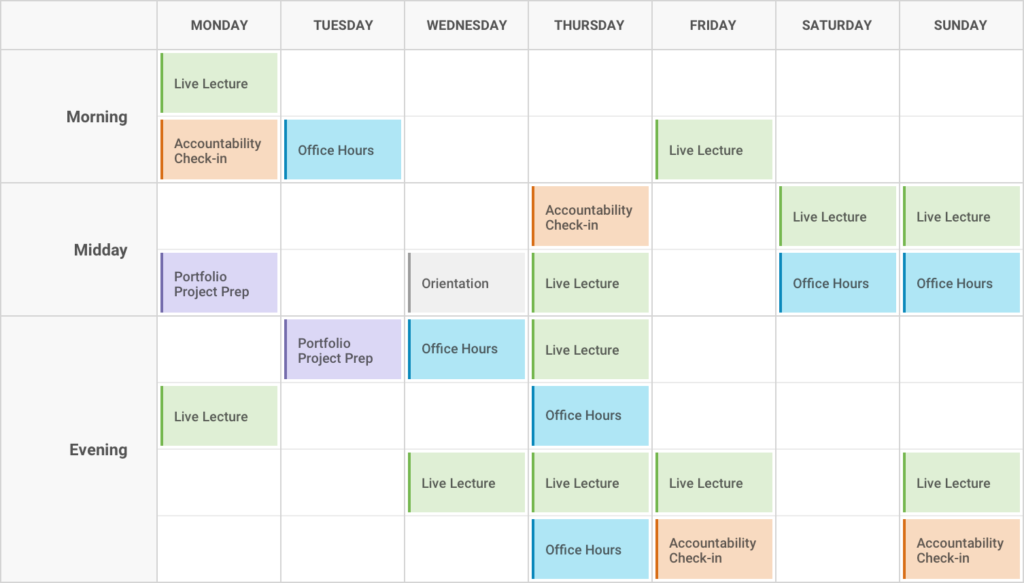When coding bootcamps first came around, what happened during a day in the life of a student was pretty clear. There was a good chance that for a three-month period, every day from around 9am to 6pm, you’d be on a bootcamp campus, partaking in technical lectures and doing a whole lot of coding.
However, it’s not quite so simple when it comes to an online coding bootcamp, such as Flatiron School’s Online Web Developer Program. For one, this program is self-paced, which changes the way people learn: students set their own schedules, making bootcamps accessible for students who need to balance their studies with a job or family responsibilities—or sometimes allowing students to go in the other direction, putting in even more hours per day than in-person students and completing the program faster.
Let’s meet some people who’ve done online bootcamps and take a closer look at how a few different learning paces put you on track to graduate, how they make code work around your life instead of vice versa, and how to get a robust learning experience on any schedule.
Take the quiz: What Coding Course Is Right For Me?
PART-TIME
- Students study 20 to 25 hours per week.
- This puts them on track to graduate in 10+ months.
- Part-time students often study on nights/weekends, but those with more job flexibility also learn during weekdays.
BJ Cantlupe spent around 11 months moving through the Online Web Developer Program. An average day for BJ included working at his day job at a library from 8 a.m. to 4 p.m., getting home by 4:30 p.m., and starting his Flatiron School studies by 5 p.m. He’d be sure to take an hour break for dinner, and then get back to studying until about 10 p.m. Some evenings he’d teach a guitar lesson and work his study sessions around that, and on weekends, he’d spend more time on Flatiron School’s online learning platform, Learn.co. “Unless I had scheduled events ahead of time, basically any free time I had was spent studying,” he says.
His favorite part of learning online with Flatiron School was working “at my own schedule, at my own pace,” he says. “Being able to set my own deadlines and expectations was the greatest contributor to my success.” But he also realizes this isn’t for everyone. “You have to consider your learning style and your life situation. If you need to work while participating in a program and you are a self-starter, an online program may be the way to go. If you struggle with self-motivation, an in-person program may be best.”
Program Mentor Chris Cole—who helps students set graduation goals and stick to them—agrees that “people can be unrealistic with their time. When setting goals and study plans with students, I make sure to ask about how quickly they’d like to finish the curriculum and their target number of hours that they can commit per week; then I ask about what other commitments a person has. It’s easy to forget that you’ve already got a full life—work, friends, family—and that you’re adding being a student in on top of everything else.”
Still, working his own schedule didn’t mean less interaction with fellow students and instructors for BJ. “I kept the Flatiron School Slack handy and often checked in on Flatiron School’s online Ask a Question feature to see what kinds of things were interesting and challenging to other students,” he says. “Towards the end of the program especially, I started getting more involved in Slack channels and asking instructors for advice and opinions.”
His advice for students learning online while working a full-time job: Don’t rush yourself. “There’s a long road ahead. Appreciate the learning process and use every frustration as an opportunity to learn something new. Remember that test failures and error messages are your friend, not your enemy. It’s all about getting it done right, not getting it done quickly.”

A look at an average week of lectures and check-ins with Flatiron School’s online education team.
FULL-TIME
- Students spend around 40 hours per week.
- This puts them on track to graduate in 6+ months.
- Full-time learners generally spend weekdays learning, sometimes with additional work on weekends.
After doing around 30 hours of exploration of free online resources, Flatiron School alumna Lindsey Wells dove into the online program full time, averaging 40 hours a week, while doing around 10 hours of part-time work per week on the side. She finished the program in just under eight months.
Lindsey kept a more flexible study schedule, sometimes starting later on in the day, knowing she was a bit of a night owl. While some students keep strict calendars for themselves, Lindsey says, “My mindset was: I’ll finish when I finish.”
Study groups, which students can easily set up within Learn.co, were an important motivator for Lindsey. Early on, she connected with fellow students at a similar point in the curriculum and they agreed to meet over video chat every Sunday. “Sometimes we’d choose a lab we were all struggling with,” she remembers. “Other times, we’d just chat about our experiences. We didn’t always keep to our Sunday schedule, but knowing that was on the calendar, that we’d be going over our progress, kept me more accountable.”

Online Web Developer Program students can learn from anywhere.
A difficulty with online learning she noticed was her own tendency to multitask: “Sometimes, as I worked through lessons, I’d make a snack or do laundry. In the end, I found 12 hours in front of the computer wasn’t always actually 12 hours of learning.” Tracy Holmes, another Flatiron School program mentor, echoes this: “One of the most common pacing issues I see is students trying to move too fast or moving slower than they anticipate because they are putting in hours… but not all work.”
Lindsey’s advice for online students moving at a full-time pace: Connect with other students and instructors over study groups, lectures, and accountability check-ins like Flatiron School’s Thoughtful Thursdays (where students have a chance to vent about non-technical challenges) —and possibly in person if you’re in a city with other students. “Taking the time to practice articulating concepts and saying things out loud rather than just pushing through labs—having that exchange of ideas—is invaluable.”
FULL-TIME PLUS
- Students put in over 40 hours per week.
- This puts them on track to graduate in 4+ months.
- Students immerse themselves in the program, spending the work week and more on their studies.
Having completed an online Masters program prior to the bootcamp, recent Flatiron School alumnus Seth Alexander was already comfortable with self-study and being disciplined with his time. “I had planned to be done in four months,” he says. “I missed it by a couple weeks.” Knowing Flatiron School’s online curriculum was over 800 hours of work, he set an ambitious schedule: on Monday through Friday, his average day would consist of taking care of his children until 8pm and then studying until 11 p.m. Then, with his wife home on weekends, he’d work 9 a.m. to 11 p.m. Saturday and Sunday. He tracked his time via Toggl.com to hold himself accountable.
Seth was able to maintain this pace in part because he had just been laid off. “My wife and I decided I could spend months, possibly, looking for work, or make the change by attending a bootcamp,” he says. And the investment paid off—Seth just accepted a front-end developer job at Rezli in Chattanooga, TN.
While moving at that rapid pace meant spending a little less time socializing with other students, Seth says, “I had Slack on my phone so I could keep up with conversations. There were people on during all hours so I never felt like the community wasn’t active.” He also chose a select few in-person coding meetups to regularly attend during the program: “I attended freeCodeCamp Nashville (I’m one of the organizers!), Nash.rb, and Nashville Software Beginners.”
Seth’s advice for others hoping to move at a full-time-plus pace: “Know yourself. An online program is not for everyone. Do Flatiron School’s Bootcamp Prep as if you were actually in the program. See if you like it after doing that.”
Ready to experience Flatiron School’s approach to online learning for yourself? Get started with our free online Bootcamp Prep course, covering over 75 hours of Javascript, Ruby, and Interview Prep.
This post originally appeared on Learn to Code with Me.
Written byJOSH HIRSHFELD
Content Marketing Manager, Flatiron School

